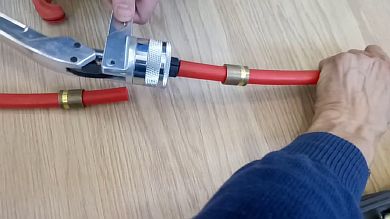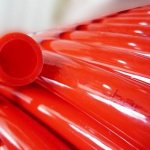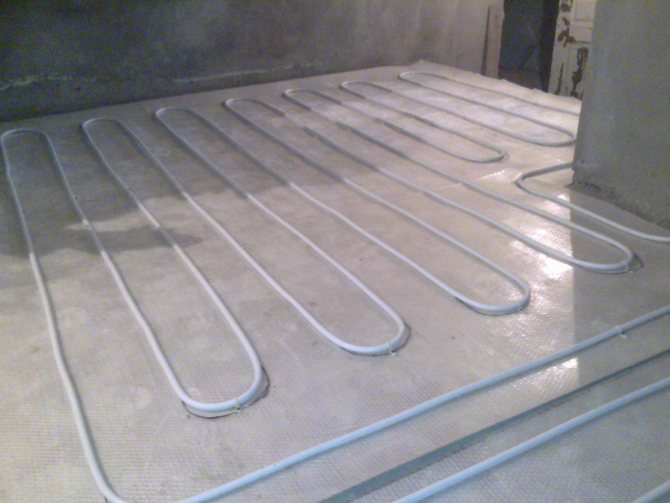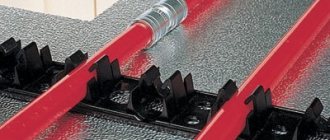Which pipes are better to use
For floor lines, only those circuits are suitable that can withstand high temperatures.
Today on the market there is a variety of products made of the following materials: copper, metal-plastic, cross-linked polyethylene. Separately, we will talk about galvanized pipe-rolling materials.
Each type has its own characteristics, and is intended for use in specific conditions.
XLPE PEX pipes
Pipes made of cross-linked polyethylene have excellent performance characteristics due to which they receive an indisputable advantage over other materials, therefore they are popular both for cold water supply and for laying in a warm floor structure.

The material for their manufacture is polyethylene with a certain density. Stitching of products is carried out according to several methods.
Depending on the production process, the pipeline is of different classes:
- PEX-a - high-density polyethylene is used in the manufacture. The method of production is peroxide, it consists in melting polyethylene under the influence of high temperature. After that, the resulting amorphous mixture is squeezed out through a special forming hole, this method is called extrusion.
PEX-a is a multi-layer construction with an aluminum insert between the layers, which helps to maintain the shape of the product. A special glue is used to connect the layers; it does not change its properties under the influence of temperature.
For your information! The product is capable of passing oxygen to the coolant. To eliminate penetration, manufacturers began to equip it from the outside with a protective EVOH coating - a layer of thin plastic (polyvinylethylene).
- PEX-b - for its manufacture, medium density polyethylene is taken, which softens to a solid consistency. With this method, crosslinking is done after extrusion.
- PEX-c - the raw material in this case is also polyethylene of medium density. Stitching is carried out at a temperature equal to the environment, while the state of the material is solid.
Cross-linked polyethylene hoses are widely used in the installation of underfloor heating, but PEX-a is more often used, since they have good elasticity, and allow you to lay a line with a bend of up to 5 diameters.
PEX-b are harder and therefore break easily. And PEX-c does not tolerate high temperatures, therefore it is more often used for cold water. In addition, products made from this material are durable and lightweight, which is a plus for DIY installation.
PEX-a pipes have memory - when deformed, they are able to completely restore their shape, for this they need to be heated. PEX-b do not have such properties, while PEX-c has this property downgraded.
Polyethylene PE-RT
Pipe rolling PE-RT is modified, it differs from PEX in the absence of seams. The system made of such tubes is practically noiseless, withstands subzero temperatures, but high positive temperatures, although it tolerates well, but not for a long time.
In addition, this material is susceptible to aggressive substances, and there is no structural memory. But, despite this, heat-resistant polyethylene is widely used in underfloor heating, as it has an affordable price.
Reinforced plastic


A metal-plastic pipe for a warm floor is an excellent option. It is flexible and pliable, and lends itself to bending even without heating. In addition, the material is durable, tolerates temperature changes well and is environmentally friendly.
The reinforced-plastic pipeline consists of several layers - cross-linked polyethylene inside, then metallized foil, and a polymer coating on the outside, it protects against mechanical damage. In such a design, corrosion does not form and scale build-up does not occur. With proper installation, the pipeline will last more than 50 years.
If we compare which is better - metal-plastic or cross-linked polyethylene for underfloor heating, then we can note the high thermal conductivity of plastic. But at the same time, there is a great risk of the coil breaking, and since such a product does not have the ability to restore its shape, this area will have to be removed.
Metallic
Metal pipes for warm water floors are produced in the following types:
- Copper - have a high cost, so they are not very popular when installing hydraulic floors. In addition, it is not easy to lay such a pipeline, special equipment is required, and it is unlikely that it will be possible to install it yourself.


However, it should be noted that a copper pipe is ideal for a warm floor, as it has excellent characteristics:
- high thermal conductivity;
- durability;
- not susceptible to corrosion;
- plasticity and strength.
- Steel corrugated stainless steel is a relatively new type that is well suited for underfloor heating, but due to the high price, they are not often used. The product has a protective polymer coating, and stainless steel does not corrode, it perfectly tolerates mechanical, chemical and temperature influences.
In addition, such a model has increased flexibility, laying according to the most complex scheme is possible, without the risk of creases.
Summing up, we can saythat the most popular models that are used for underfloor heating are reinforced plastic pipe or XLPE loop.
They have good performance and are affordable. But if financial resources allow, then it is better to use a metal (copper) pipeline, it has high thermal conductivity and durability.
How is the main installation carried out?
For water underfloor heating, you will need a flat surface of the rough base. It is recommended to perform a screed, self-leveling floor or use a self-leveling mixture. Plumbing is laid on a dry surface. It is recommended to use insulating materials so that all the heat from the water circuit is directed to the floor.
- The base is covered with a thin plastic wrap.
- I install thermal insulation. It is recommended to use Rehau polystyrene contour covering. The PEX underfloor heating pipe fits well to the contour of the coating. The line is laid with a "snake" or "snail", outlining the protruding bosses. They squeeze the pipe from the sides, fixing it securely in a certain place.
- The line is fed to a manifold that has an outlet for hot and chilled water. Connect the entire system to the heating boiler. Testing the heating system.
- Pour underfloor heating with PEX pipes with a concrete screed up to 8 cm deep.
We recommend: How to choose a plasticizer for a warm floor?


Foam plates are used as insulation for the base of the floor. Foil material is placed on the plates. It is a reflective screen that directs heat upward. Reinforced mesh and mounting brackets are used to strengthen the line.
The staples are installed on the mesh with a certain pitch. They are made of plastic and have downward prongs. The teeth will not allow the water circuit to change position, to get out of the groove.
PEX pipes are used not only for floor heating, but also for cold and hot water supply. Corrosion and salt deposits do not form on the inner surface of the product, which prolongs the service life of the water circuit.
When heated, PEX-a cross-linked polyethylene does not emit toxic substances.The products are used in pharmacological enterprises. Cross-linked polyethylene for PEX-a and PEX-c are classified as environmentally friendly products.
YouTube responded with an error: Access Not Configured. YouTube Data API has not been used in project 268921522881 before or it is disabled. Enable it by visiting https://console.developers.google.com/apis/api/youtube.googleapis.com/overview?project=268921522881 then retry. If you enabled this API recently, wait a few minutes for the action to propagate to our systems and retry.
- Similar posts
- Features of underfloor heating Legrand
- How to connect a warm floor?
- How to make a warm water floor in a private house with your own hands?
- How to make a warm floor?
- How to put underfloor heating in the toilet?
- Should I use Penoplex for underfloor heating?
Is it possible to connect underfloor heating pipes or not?
When laying a pipeline for a warm floor, it is not uncommon that the length of the circuit is not enough to make a one-piece loop. In this case, the question arises - is it possible to connect the pipes together, and how to do it? There are several methods for connecting contours, which depend on the type of material.
Important! When choosing a method to join the floor pipes, the operating pressure should be taken into account, since each joint is designed to withstand a certain load.
Let us consider in more detail the methods - how to connect the pipes of the warm floor.
Connection of pipes made of cross-linked polyethylene and metal-plastic
Contours made of polyethylene or metal-plastic can be sewn using fittings (brass, bronze and plastic), they are able to withstand high temperatures. Fittings are:
- Electric welding ones are effective, but special equipment is required for their installation, therefore they are rarely used. The process looks like this:
- an electric welding fitting is put on the pipe cut;
- welding equipment is connected to the terminals, it will supply voltage to the element, which will lead to heating and fusion of the joints;
- the device turns off, the resulting connection is able to withstand pressure up to 12 Amp.
- Pressing - the main plus is that during pressing, the entire space is filled with polymer, thereby obtaining a high-strength connection.
Sequencing:
- a nut is put on the edge of the crimp tube, with the thread towards the connection;
- the split ring is put on with an indent from the cut by 1 cm, and is fixed;
- the hose is stretched with a fitting for the fitting;
- the crimp nut is tightly tightened with two wrenches.


- Crimp fittings are the easiest to install at home:
- a clamping sleeve is put on the polymer hose;
- the end of the contour is stretched in diameter using an expander;
- the stretched edge of the tube is pulled up to the stop on the fitting of the fitting;
- the joint is fixed in this position for several minutes, this is enough for a tight splicing of the fitting.
Stitching copper pipes
As well as when installing a plastic circuit, copper can be joined using press or push fittings. This method is recommended in open areas, so that in case of a leak, you can easily change the part.


But, the most reliable and practical is to solder copper pipes. This is a more time-consuming process, but the connection is durable and reliable. Sequencing:
- contour cuts are cleaned from the outside and from the inside;
- with a special connector for soldering pipes of a warm floor made of copper, the edges of the parts are lubricated - only from above;
- the products are joined, and the excess mixture is removed;
- the joint is heated with a gas torch and the solder fills the gaps.
How to connect underfloor heating pipes (press fitting)
As mentioned above, the pipeline can be connected using press fittings. This part consists of:
- body - it can be of different shapes (angle, tee, coupling);
- sleeves - the basis of the fitting, stainless steel is the raw material for its manufacture;
- clips - an elastic ring (gasket) that connects the body and the sleeve.


For your information! The body of the fitting is equipped with a "window" to control the correct insertion of the tubular product. Only when the tube is visible in this hole can you start pressing.
Pressing is carried out using special pressing tongs. The essence of the procedure is to squeeze the handles of the instrument.The process is quick and easy, and no special skills are required to carry out these works.
The advantage of using such a connection is strength, long service life and the structure does not need maintenance.
Fitting
What fittings to use. They are of two types:
- Press. Collapsible, crimp or compression.
The first ones are easier and faster to install, but the equipment for them is expensive and not available everywhere.


The latter are cheaper to install, but it makes sense to use them if the object is small, since the time costs are very significant.
Compression fitting process:
- Both parts of the pipe are brought to a perfect circle with a calibrator. Then the burrs are removed with sandpaper (some calibrators have a chip remover). A crimp nut and a union ring are twisted from the fitting. The quality of the sealing ring is checked - it should not protrude from the groove. The union nut is put on the first section of the pipe, then the compression ring (cracker). The fitting of the fitting is inserted all the way. The nut and the ring are moved to the fitting and tightened. With open-ended wrenches, the nut is tightened to the end.
Press Fitting Process:


- The edge of the pipe is processed with a calibrator, cleaned. A crimp fitting is put on the pipe (the fact that the fitting has entered deep enough is shown by an indicator - a special window). A nozzle is inserted into the press under the corresponding diameter (the base of the tool rotates, so it is convenient to work with it in any place and position The pipe is placed in the mouth of the press and crimped in a few seconds.
As already mentioned, no connecting fitting should get into the concrete. If you already have to dock a pipe in a room, the fitting can be brought to the wall and covered with a baseboard.
It is best to make turns and bends with a special pipe bender.
It is a hand-held, lightweight tool that allows you to very quickly and accurately perform any shape and configuration.


Often, ordinary people do not have a pipe bender. And if the budget is limited, and the quality of the bend is not too worried about, then you can do with the manual method, with a spring - a conductor. This is an inexpensive device (about 150 - 300 rubles) that will help to avoid marriage.
The fact is that if you simply bend pipes by hand, then, without sufficient experience, you can easily exceed the permissible radius, flatten and break the pipe. The conductor will help to make a bend from three pipe radii. It can be internal (it is more convenient to work, but with small sections of pipe) and external, which is easier to move over a long section.
Connecting underfloor heating pipes in a screed


Although experts advise laying a water-heated floor under a screed without joints, it is not forbidden to do them.
But it is worth noting that it is impossible to connect the floor contours by a threaded method: "American" or PRH. It is better if the pipes will be connected using a press fitting or coupling.
Important! When filling such areas with screed, fittings or couplings should be isolated from the concrete solution. This can be done by wrapping them in plastic wrap.
Professional advice
Before installing the waterproofing sheet, it is necessary to thoroughly clean the surface and remove all debris. Also, the presence of chips and cracks is not allowed - they must be repaired before starting work.


Insulation should be installed end-to-end or overlapped. The joints should be sealed with wide tape. In the areas where the walls meet, you can also leave a little insulation, which will later be covered with a screed. The entire sub-floor must be covered with insulating material.


When installing a warm floor, it is not recommended to place pipes in those places where furniture will stand in the future, in order to avoid overheating of these areas.
The pipe fixing strips are installed at the same distance (50-70 cm), perpendicular to the wall where the collector will be located.


The manifold is installed before the pipes are laid. When installing it, you must make sure that the surface can withstand the necessary loads: the weight of the equipment itself and all the connecting elements.


To prevent cracking in large rooms, professionals divide the area to be treated into segments using a damper tape. The supply pipe is connected only in the direction from the collector.


It is imperative to test the finished pipeline structure. The check is carried out under a pressure of at least 5 atmospheres and for a period of at least one day. When the screed is being poured, the system is turned off


Even with self-installation of a warm water floor, there are works that are best entrusted to a narrow specialist. For example, the connection of the collector after the boiler pump and in front of other radiators should only be carried out by professionals. It is also better to entrust the installation of thermostats to a specialist.
The underfloor heating system is not a cheap pleasure, but it will also serve (if properly installed) guaranteed for up to 50 years. Therefore, you should not save on materials and work on its installation: it is better to give preference to higher quality materials and services to obtain the appropriate result.
Article Rating
How to solder a floor heating pipe
Soldering is a common method of connecting plastic pipes for underfloor heating. The technology is simple and does not require large financial investments. There are two soldering techniques:
- Coupling - for this, a shaped part is used (a coupling or a contour with a large diameter). This method is suitable for 63 mm tubing. The welding process consists in melting the edge of the product from the outside and part of the sleeve inside. After that, the parts are joined, forming a tight connection.
- Straight line - consists in melting small sections of two plastic pipes, which are then joined by their ends. This rather simple method reliably combines two parts into a single contour.
For your information! Along with hot technologies, the method of "cold" soldering is practiced. A special solvent is used that softens the plastic.
How to connect a pipe underfloor heating with a metal-plastic pipe
Although experts recommend using a pipeline made of one material when installing a warm floor, sometimes it becomes necessary to connect a metal-plastic circuit with products from other raw materials.
For example, when connecting this circuit to steel (copper) parts of the water supply or heating. This requires a compression fitting and a calibrator. When joining products from different materials, the thread should be selected according to the size of the steel pipe, and the collars and washers - along the metal-plastic pipeline.
Tow is wound around the copper pipe, and then the fitting is screwed on. The edge of the product is pushed onto the cone and the nut is tightened.
If it is necessary to dock the reinforced-plastic circuit with polyethylene products, special threaded fittings can be used as a connector for underfloor heating pipes. Such a joint is more often done when connecting a warm floor to a boiler.
Copper pipes
Of course, copper is the best option when choosing pipes for underfloor heating. It has excellent thermal conductivity of all of the above. Copper pipes are durable and strong, there is less likelihood of leaks due to mechanical damage.
But the installation of copper labor requires additional equipment and time, therefore it is the most expensive option.
You can check the price with the employees of the Stroy-climate company.


If a decision is made to install a water heated floor in the house, all the pros and cons of each material are usually carefully considered.
Is it worth installing a warm floor made of metal-plastic pipes - is it profitable, reliable, and if so, how to do everything right with your own hands.
Metal-plastic is a five-layer Pex-al-pex tube (Polyethylene, glue, foil aluminum, glue, polyethylene).


A layer of aluminum (about 0.2 mm) is the main difference between the composite and high-strength polyethylene.
What does such a structure give.
What to do if the underfloor heating pipe has been punctured?


In the presence of warm water floors in a house or apartment, there are times when the floor pipeline can be broken. First of all, if the floor is functioning, it should be disconnected from the water supply. But more often, such damage occurs during the installation or repair of the system, when the topcoat is not laid and the screed is not poured - this is a huge plus.
If there is a concrete screed, you will need a hammer drill, chisel, and hammer to locate the damage. This should be done carefully so as not to damage the whole circuit.
When punching pipes made of metal-plastic or polyethylene, they are repaired with press couplings, using a special press.
For your information! If the heating element after repair will be filled with a screed, then the use of threaded fittings is not possible.
Having calculated the place of breakdown, the damaged area should be removed, and a whole circuit should be installed in its place. The connection is carried out using press sleeves, which should be wrapped in plastic wrap to protect against cement mortar.
The cost
The price of a metal-plastic pipe for a warm floor varies depending on the manufacturer.
Metal-plastic is one of the most inexpensive options for installing heating, if you resort to the services of construction organizations. The cost of a running meter can be from 120 to 500 rubles.


As a rule, all necessary operations are included in the price - cleaning, joining with corners and fittings.
The cost of the metal-plastic pipe itself will depend on the manufacturer and the cross-section. On average, it is 35 - 90 rubles per running meter.
Fittings can vary greatly in price, depending on the type of metal, as well as the configuration. Prices for crimp fittings 130 - 380 rubles. Complex corners, adapters and tees can cost 500 - 700 rubles per unit.


Press fittings are a little cheaper, on average, 100 - 250 rubles.
Can the pipes be lengthened if there is not enough length?
As you know, making a loop of a warm water floor is better than a solid one, this gives the system reliability, and the connections are made at the attachment points with the collector. With a large size of the heated room, it is recommended to divide the area into several branches.
In order not to make a mistake in the size of the loop, you should correctly calculate. To do this, you can use an online calculator.
However, it is still possible to lengthen the underfloor heating circuit, if necessary, by connecting the missing pipe section to it, which, by the way, is permitted by GOST. It is possible to build up floor loops with heating using various methods; for this, butt joints are used - more often press fittings.
For your information! It is recommended to use piping and fittings from the same manufacturer in such cases.
Summing up, we can say that the connection of underfloor heating pipes is permissible, and there are various ways. But it is more practical and more reliable to lay a solid loop, especially under the screed, so that in case of a leak, you do not have to destroy the concrete layer.
In addition, you should give preference to high-quality tubular products and fittings from trusted manufacturers. In such cases, the heating floor will serve you for a long time and will create a comfortable atmosphere in the house.
Which system to choose
Thermoregulator for water underfloor heating
Underfloor heating systems are divided into water-based and electrical ones. Both types are in demand, and it is impossible to say for sure which one is better. To determine the choice, you should familiarize yourself with their characteristics, compare the pros and cons.
Water floor
The main condition for the installation of water floors is the possibility of direct connection to the central heating system or the arrangement of a separate boiler room. In apartment buildings, such floors can only be used if they were originally included in the project. In standard city apartments, their installation is prohibited, since the water pressure in the system is designed exclusively for radiator heating.


Water heat-insulated floor
For the installation of underfloor heating, metal-plastic or polymer heat-resistant pipes are used, thanks to which the system operates smoothly for 40-50 years, provided that it is properly installed and connected. Such heating is low temperature and is most often used as auxiliary heating. At the same time, it can also act as the main source of heat, especially for small spaces.


Pipes for water underfloor heating


The structure of the polyethylene pipe


Table of characteristics of polypropylene pipes
The system consists of a distribution unit, which includes a manifold, pump and mixing unit, and a heating circuit. The optimal area for heating with one circuit is considered to be 10-15 m2, therefore, for large rooms, a system is designed with several circuits and the possibility of separate shutdown of each of them.


Collector diagram for warm water floor
Advantages of a water floor:
- long service life;
- low energy consumption;
- security;
- there are no restrictions on the arrangement of furniture.
Minuses:
- the complexity of design and installation;
- large thickness of the structure and, as a result, high load on the base;
- in the event of a leak, a major overhaul of the floor and a complete replacement of the circuit are required.
Electric floor
Electric underfloor heating systems are equipped with various types of heating elements, and, depending on this, are divided into cable, film and thermomats.
| Floor type | Characteristics |
| Cable | The most common type, characterized by the simplicity of the device. Installed in a screed or a layer of tile adhesive, it is convenient when laying in a small area. The cable is produced completely ready for installation, so it cannot be shortened or extended. In order to avoid overheating, after installation, furniture must not be placed above it. |
| Film | It is a thin strip of heat-resistant polyester with heating elements sealed inside. Such a device provides very fast and uniform heating. Foil floors are assembled from individual parts on site and placed directly under the floor covering. They cannot be installed in the screed and tile adhesive, since the alkaline environment destroys the film |
| Thermomats | A kind of cable system. Available in thin fiberglass rolls with fixed cable. When installing on difficult surfaces, it is permissible to cut fiberglass to make it easier to unfold part of the section. The use of electric mats greatly simplifies the installation of the system |

































